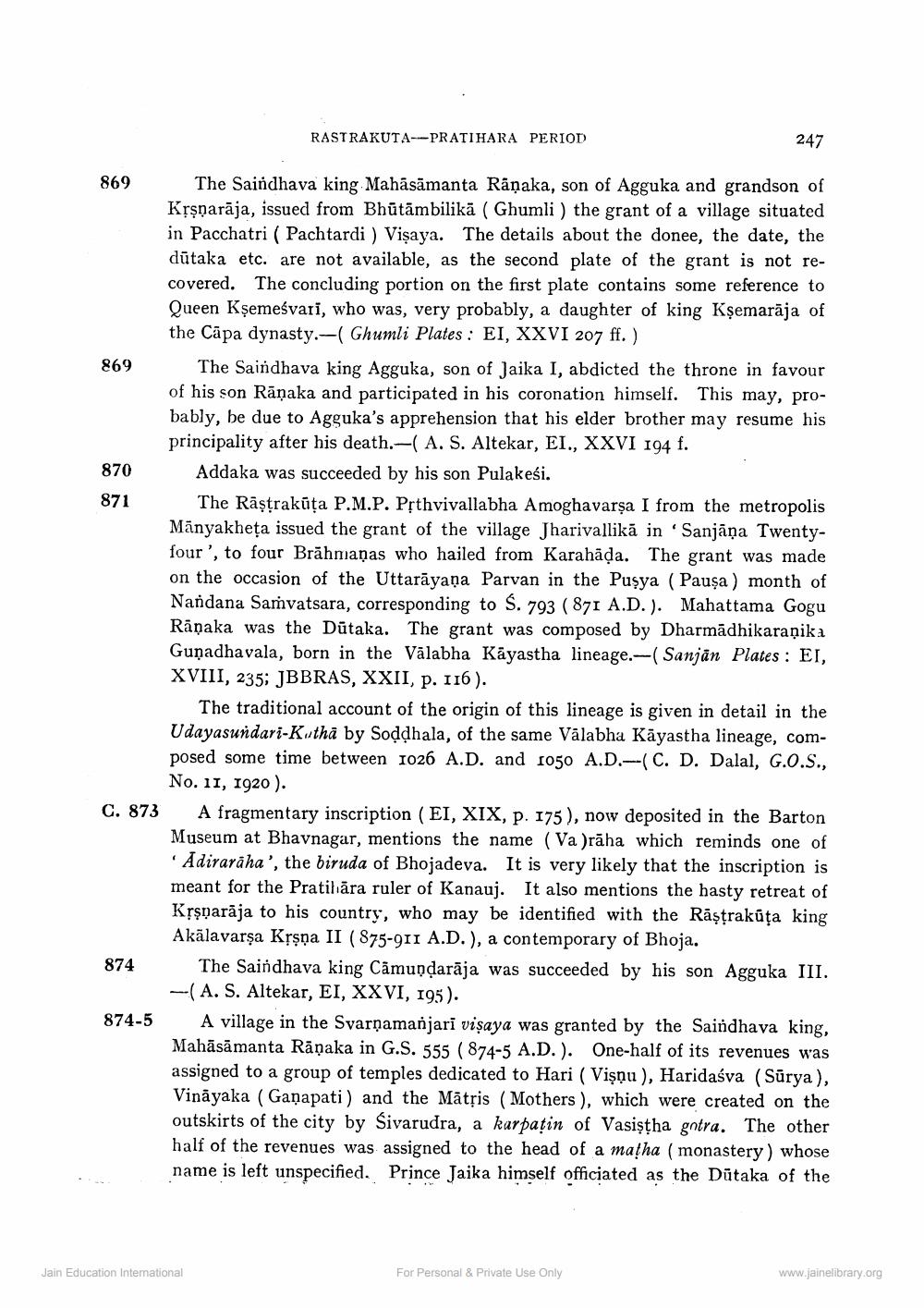________________
RASTRAKUTA---PRATIHARA PERIOD
247
869 The Saindhava king Mahāsāmanta Rāņaka, son of Agguka and grandson of
Krşnarāja, issued from Bhūtāmbilikā ( Ghumli) the grant of a village situated in Pacchatri ( Pachtardi ) Vişaya. The details about the donee, the date, the dūtaka etc. are not available, as the second plate of the grant is not recovered. The concluding portion on the first plate contains some reference to Queen Kșemeśvari, who was, very probably, a daughter of king Kșemarāja of
the Căpa dynasty.-( Ghumli Plates : EI, XXVI 207 ff.) 869
The Saindhava king Agguka, son of Jaika I, abdicted the throne in favour of his son Rāņaka and participated in his coronation himself. This may, probably, be due to Agguka's apprehension that his elder brother may resume his
principality after his death.-( A. S. Altekar, EI., XXVI 194 f. 870 Addaka was succeeded by his son Pulakesi. 871 The Rāştrakūta P.M.P. Přthvivallabha Amoghavarşa I from the metropolis
Mānyakheţa issued the grant of the village Jharivallikā in Sanjāņa Twentyfour', to four Brāhmaṇas who hailed from Karahāda. The grant was made on the occasion of the Uttarāyaṇa Parvan in the Puşya (Pausa) month of Nandana Samvatsara, corresponding to $. 793 ( 871 A.D.). Mahattama Gogu Rāņaka was the Dūtaka. The grant was composed by Dharmādhikaraṇika Gunadhavala, born in the Vālabha Kayastha lineage.-- Sanjān Plates : EI, XVIII, 235; JBBRAS, XXII, p. 116).
The traditional account of the origin of this lineage is given in detail in the Udayasundari-Kutha by Soddhala, of the same Valabha Kāyastha lineage, composed some time between 1026 A.D. and 1050 A.D.--(C. D. Dalal, G.O.S.,
No. 11, 1920). C. 873 A fragmentary inscription (EI, XIX, p. 175), now deposited in the Barton
Museum at Bhavnagar, mentions the name (Va )rāha which reminds one of
Adiraráha', the biruda of Bhojadeva. It is very likely that the inscription is meant for the Pratilāra ruler of Kanauj. It also mentions the hasty retreat of Krşparāja to his country, who may be identified with the Rāştrakūta king
Akālavarşa Krşņa II (875-911 A.D.), a contemporary of Bhoja. 874 The Saindhava king Câmundarāja was succeeded by his son Agguka III.
-(A. S. Altekar, EI, XXVI, 195). 874-5 A village in the Svarṇamanjarī vişaya was granted by the Saindhava king,
Mahāsāmanta Rāņaka in G.S. 555 ( 874-5 A.D.). One-half of its revenues was assigned to a group of temples dedicated to Hari ( Vişņu ), Haridaśva (Sūrya), Vināyaka (Ganapati) and the Mātộis (Mothers), which were created on the outskirts of the city by Sivarudra, a karpațin of Vasiştha gntra. The other half of the revenues was assigned to the head of a matha (monastery) whose name is left unspecified. Prince Jaika himself officiated as the Dūtaka of the
Jain Education Interational
For Personal & Private Use Only
www.jainelibrary.org




